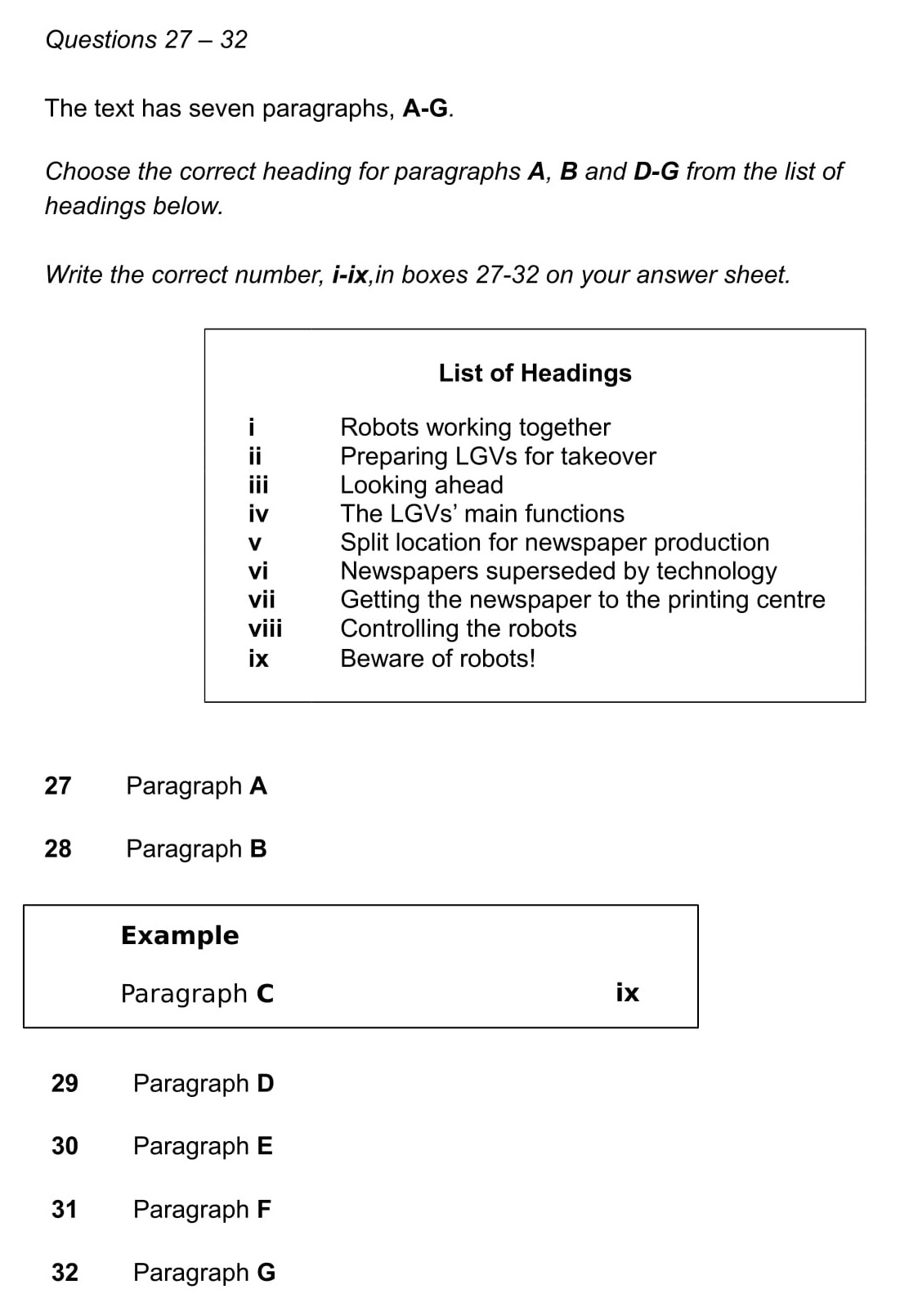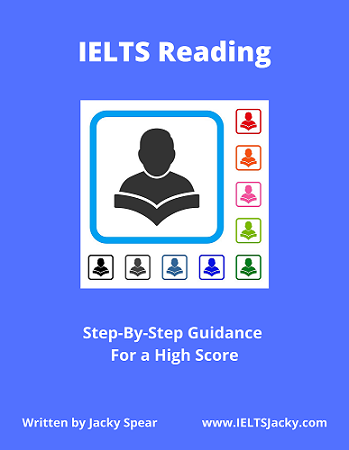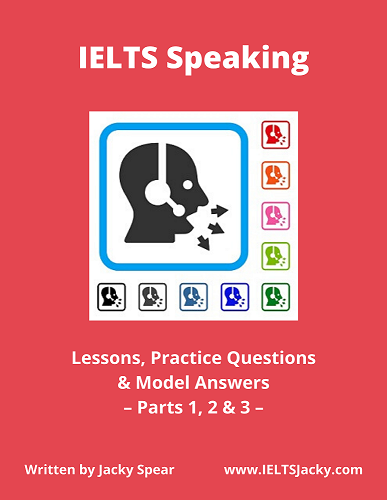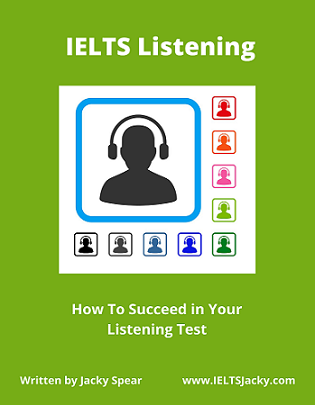IELTS Reading Practice Test
How To Answer
Matching Headings & Diagram Labelling Questions
This IELTS Reading practice test comes from a real test paper. I’m going to use it to show you step-by-step how to answer two different types of questions based on one text.
Both question types are common in the reading test. I’ve written a full page on each of them where you can find lots more information and tips, including additional IELTS reading practice tests. Click the links to visit these pages:
Matching Headings & Diagram Labelling
IELTS Reading Practice Test 1 – Matching Headings
The first question type we're going to work with on this page is Matching Headings. There are a few key things that it will help you to know about them before we begin.
a) The aim of Matching Headings questions is to test your understanding of the main idea of each paragraph.
b) You will be given a text with several labelled sections, for example, A-G, and a list of possible headings to match each section. Your task is the match them up. However, there will be more headings than there are sections so you won’t need them all.
Also, several headings may be similar in meaning so you'll need to make sure that you understand the difference between them.
c) In this type of question, expect there to be extensive paraphrasing and use of synonyms.
d) If you’re really struggling to find the correct heading match for a specific paragraph, move on and come back to it when you’ve eliminated some of the headings in the list.
e) There are two possible strategies for answering Matching Headings questions:
1) Read the text first, then the headings.
2) Read the headings first, then the text.
Views differ as to which is the best strategy but I think the first one is the easiest so, it’s the one I’ll be showing you here. I do, however, explain both strategies on the main Matching Headings page.
Here’s the text we’ll be working with and the first set of questions for our IELTS reading practice test.
You may want to have a go at answering them yourself before reading my instructions. I’ve added a PDF of the text and both sets of questions that you can download to make it easier to work on. The answers are at the bottom of this page.
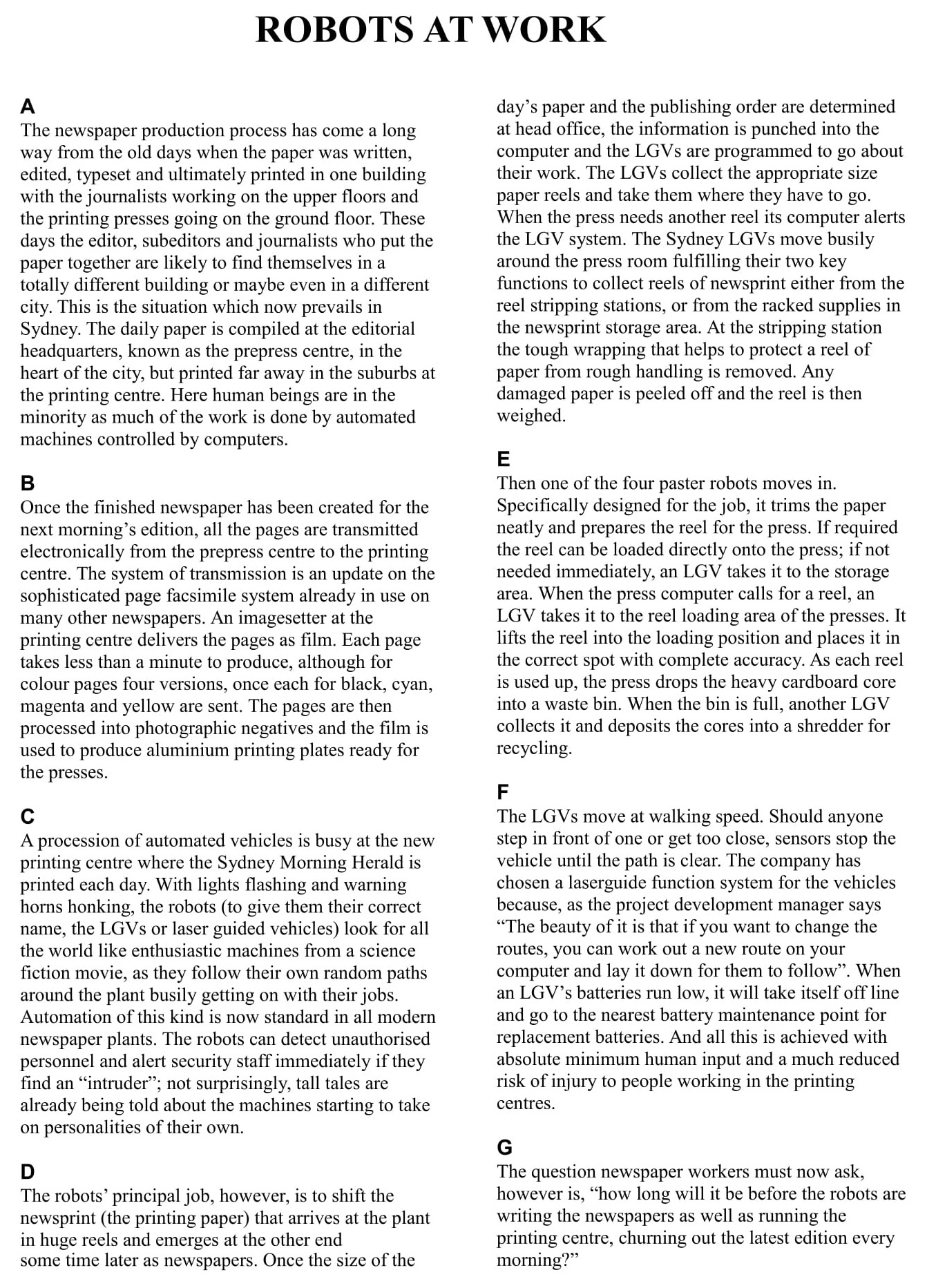
Download PDF of IELTS Reading Practice Test.
Step-By-Step Instructions
1) Read the instructions carefully to make
sure that you know what type of question it is and what you have to do.
The headings are in the middle of the instructions but remember, for this strategy don’t read them yet.
There will sometimes be a sample answer for illustration. In this case, it’s the answer to Section C. Knowing this answer means that you can immediately cross out ‘heading ix’ in the list and eliminate it from further consideration.
Extra Tip: If one of the headings is about the future, e.g. iii Looking ahead, it is most likely to match the last paragraph.
2) Read the title of the text and the first paragraph.
Your aim is to identify the main ideas. Focus on the first one or two sentences and the last sentence as these will probably introduce and summarise this main idea. Skim read the rest of the text. You do not need to know all the detail for this type of question.
3) Summarise
the main idea.
Briefly sum up the main idea of the paragraph in your own words. Do it in just a few words or a short phrase at the most. Write this beside it.
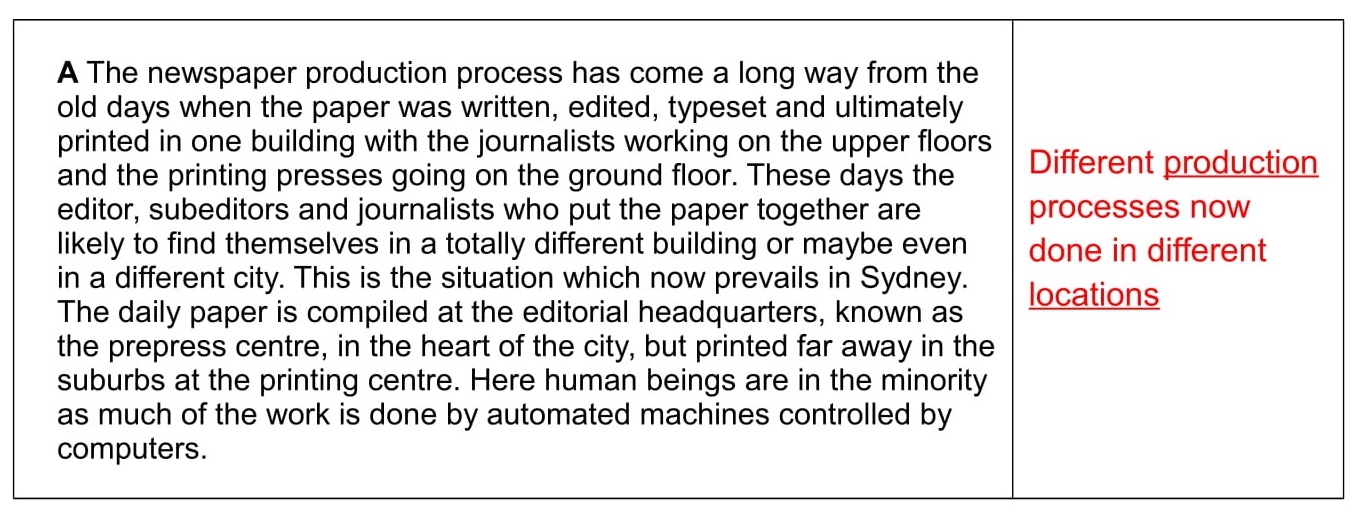
4) Read the headings
Now go to the list of headings. Read through them and try to match your notes on the first section to one of the headings.
Be aware that there may be two that are very similar in meaning so don’t just select the first one that seems to match. Read all the headings carefully.
Matching key words in headings and text will help you choose the right one but remember that synonyms are very likely to be used.
In this instance, there is one heading with
two key words that match my summary notes.
v Split location for newspaper production
The matching words are ‘production’ and ‘location’. This is a clear match of information.
So, the answer is: Paragraph A v.
You can see how time spent making notes when skimming saves having to read through the text again to search for the information.
5) Now skim read paragraph B. Again, try to identify the main idea and summarise it in a brief note beside the paragraph.
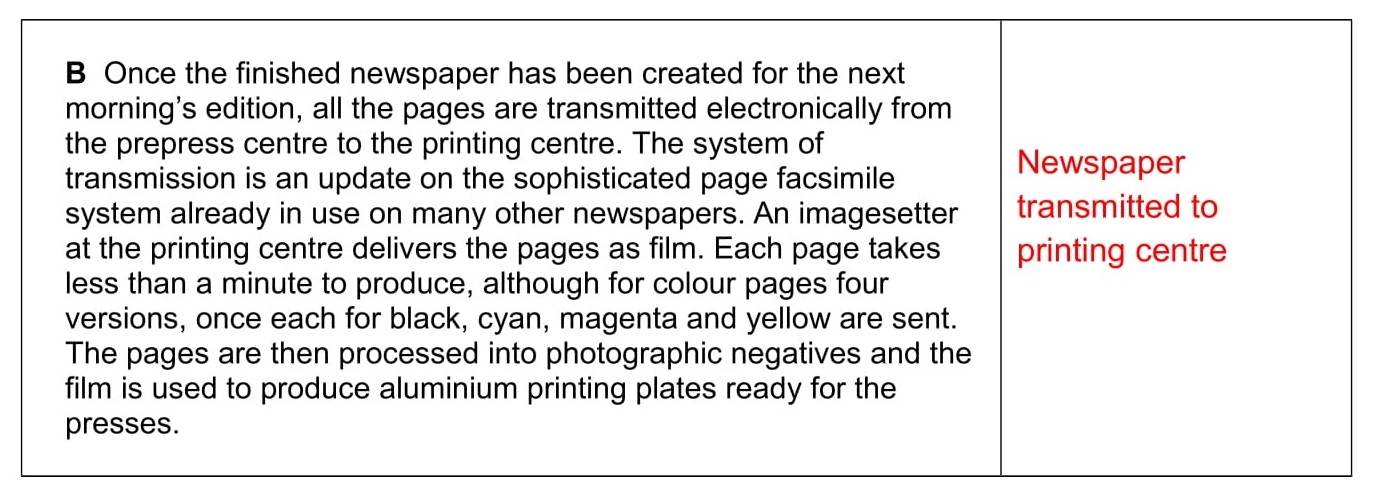
Now go back to the list of headings. Read through them and
try to match your notes on Section B to one of the remaining
headings.
There’s one clear match.
vii Getting the newspaper to the printing centre
So, the answer is: Paragraph B vii.
6) The heading match for paragraph C has been given as an illustration so we can move straight on to paragraph D.
Skim read and write your summary as before.
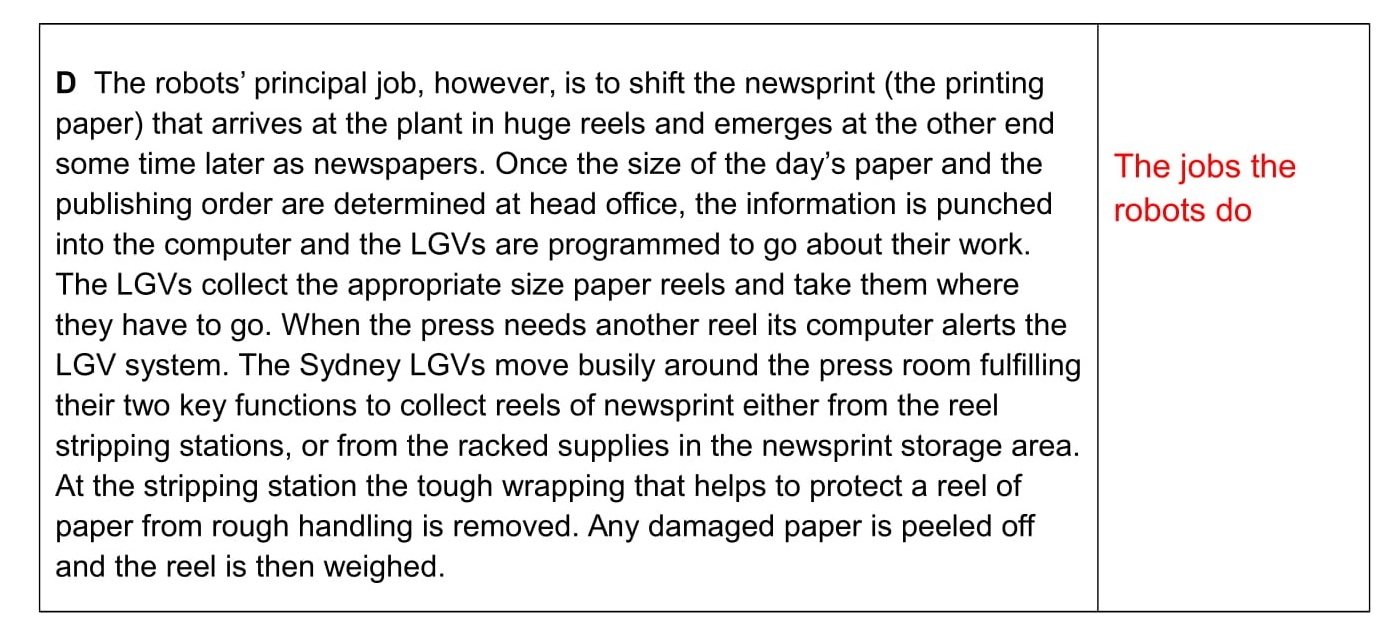
There is an acronym in this paragraph – LGV. It didn’t
appear in paragraphs A or B and isn’t explained here so you can conclude that
the actual words will be in paragraph C which we haven’t read.
It’s clear from the context of the text that LGV refers to the robots so there isn’t really any need to know the words unless it’s necessary to understand them in order to match the heading.
If you do feel that you need to know them, quickly scan paragraph C for ‘LGV’. It’s easy to spot and confirms that it does mean robot or, more specifically, ‘laser guided vehicles’.
… the robots (to give them their correct name, the LGVs or laser guided vehicles) …
7) So, let’s look at the headings to find our match. There are four unused headings with either the word ‘robot’ or the acronym ‘LGV’ in them.
i Robots working together
ii Preparing LGVs for takeover
iv The LGVs’ main functions
viii Controlling the robots
The quickest way to find the right one is by a process of elimination.
In my summary, I’ve noted that the paragraph is about what the robots do. This doesn’t fit with headings ii or viii so we can eliminate these. If you’re not sure, you can skim read again to check.
So, we are left with two possible matches:
i Robots working together
iv The LGVs’ main functions
The paragraph certainly states that the robots are ‘working together’, as in heading i, but this isn’t the main idea. The main idea is an explanation of what the LGV’s are actually doing, as I’ve noted in my summary. Thus, we can probably eliminate i.
Heading iv, on the other hand, includes the word ‘functions’ which means the natural purpose or activity of something. If you know this, you will easily identify heading iv as the correct answer.
Answer: Paragraph D iv
Cross it through in the list and move on to the next paragraph.
8) Paragraph E is a continuation of the ideas in paragraph D but more about how the robots work together but do different
jobs. As I write my summary, I can immediately guess which heading will be the
correct match as we've just been considering it for the previous answer.
i Robots working together
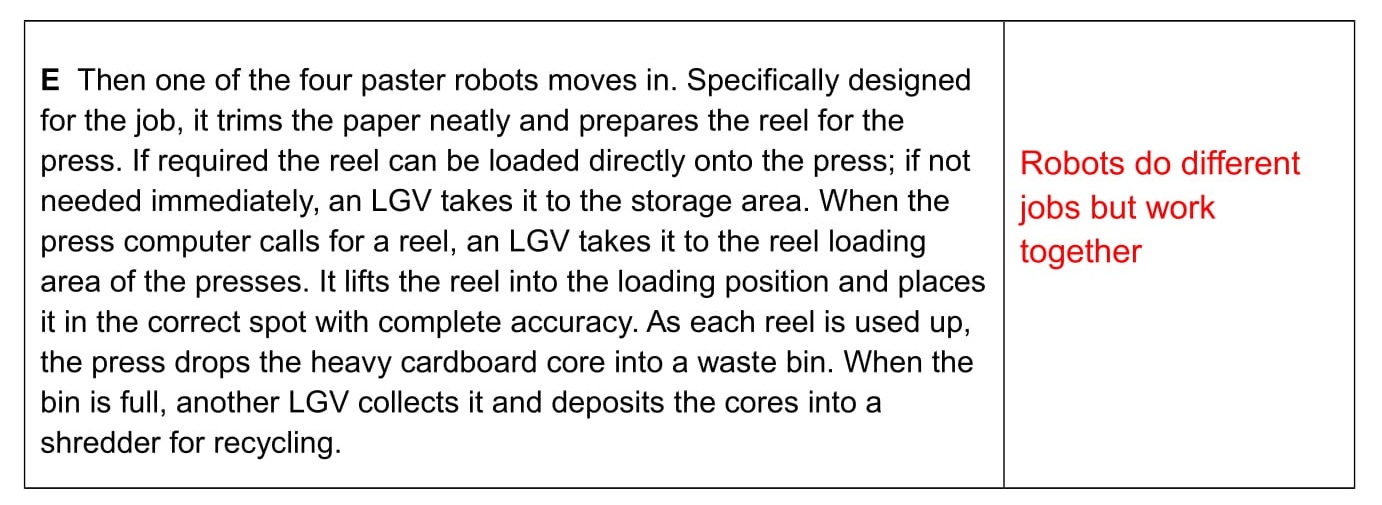
I quickly read the other headings that are left but there
can be no doubt that this is the correct one.
Answer: Paragraph E i
9) There are now just four headings left unmatched. When you reach this stage in the question, it may be quicker to change strategy and read the headings before you skim the paragraph. Let’s try this.
Here are the four remaining headings:
ii Preparing LGVs for takeover
iii Looking ahead
vi Newspapers superseded by technology
viii Controlling the robots
They all have very different meanings so that makes it easier.
Read the headings then skim read paragraph F. Are any of the headings a clear match with the main idea? Yes. The paragraph is about ‘controlling the robots’ which exactly matches heading viii. Key phrases include:
- sensors stop the vehicle
- change the routes
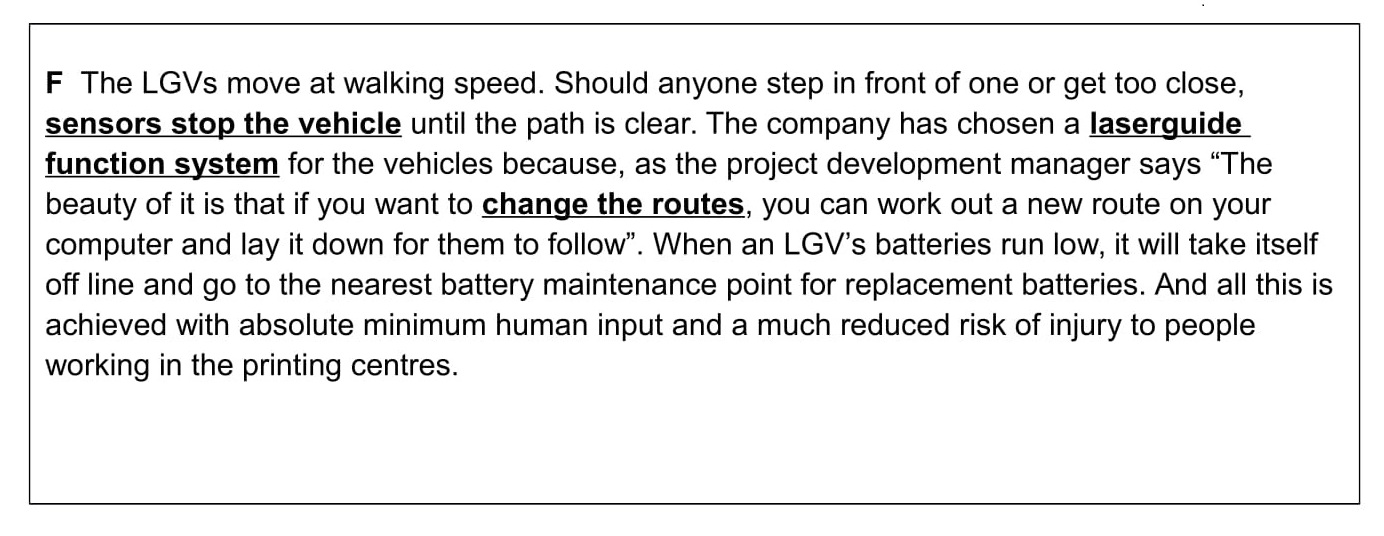
Quickly check the other headings to ensure there isn’t a
better match. There isn’t.
Answer: Paragraph F viii
10) We are now on the final paragraph with three possible heading matches left:
ii Preparing LGVs for takeover
iii Looking ahead
vi Newspapers superseded by technology
Again, read the headings first, then the text.

This may be just a short paragraph, but the answer isn’t obvious. At first glance, any of the headings could be a match. We need to think very carefully about their meanings.
Writing the headings one beneath the other will help you focus in on the difference between them. Let look at each one in turn.
Heading ii – Preparing
LGVs for takeover
The text certainly suggests that there may come a time when the robots will 'take control' of everything, which is what ‘takeover’ means. However, it doesn’t state that they are being prepared for this. So, it’s not ii.
Heading iii – Looking head
This means ‘looking to the future’ and would be a good match for the paragraph, but we’ll quickly check the final heading.
Heading vi – Newspapers superseded by technology
The key to understanding this heading is knowing what ‘superseded’ means.
- to supersede – to replace something, especially something older, less effective, or less important
In the text, it is the newspaper workers who are at risk of being replaced by technology, not newspapers themselves so this can’t be the matching heading.
The answer must be: Paragraph G: iii
So, we’ve completed the first set of questions for our IELTS reading practice test. Now we’ll move on to Part 2.
IELTS Reading Practice Test Part 2 – Diagram Labelling
The second set of questions on this IELTS Reading practice test are based on a flowchart. Here are a couple of key things that you need to know about this type of question.
a) You are required to fill in gaps with words from the text or a word list.
b) The instruction will tell you how many words you’re allowed to use for each label, in this case, NO MORE THAN THREE WORDS.
c) Being a flowchart, you know that the answers will come in order in the text. This makes flowcharts easier to complete than other types of diagram labelling questions.
There are lots more tips and information on the main Diagram Labelling page.
So, here’s the flowchart. The text is the same as for the Matching Heading questions. If you want to use it as a practice test, have a go at completing it yourself before reading my instructions.
Here’s another link to the PDF of the whole IELTS reading practice test for you to download and work on. The answers are at the bottom of this page.
Download PDF of IELTS Reading practice test – Robots at Work
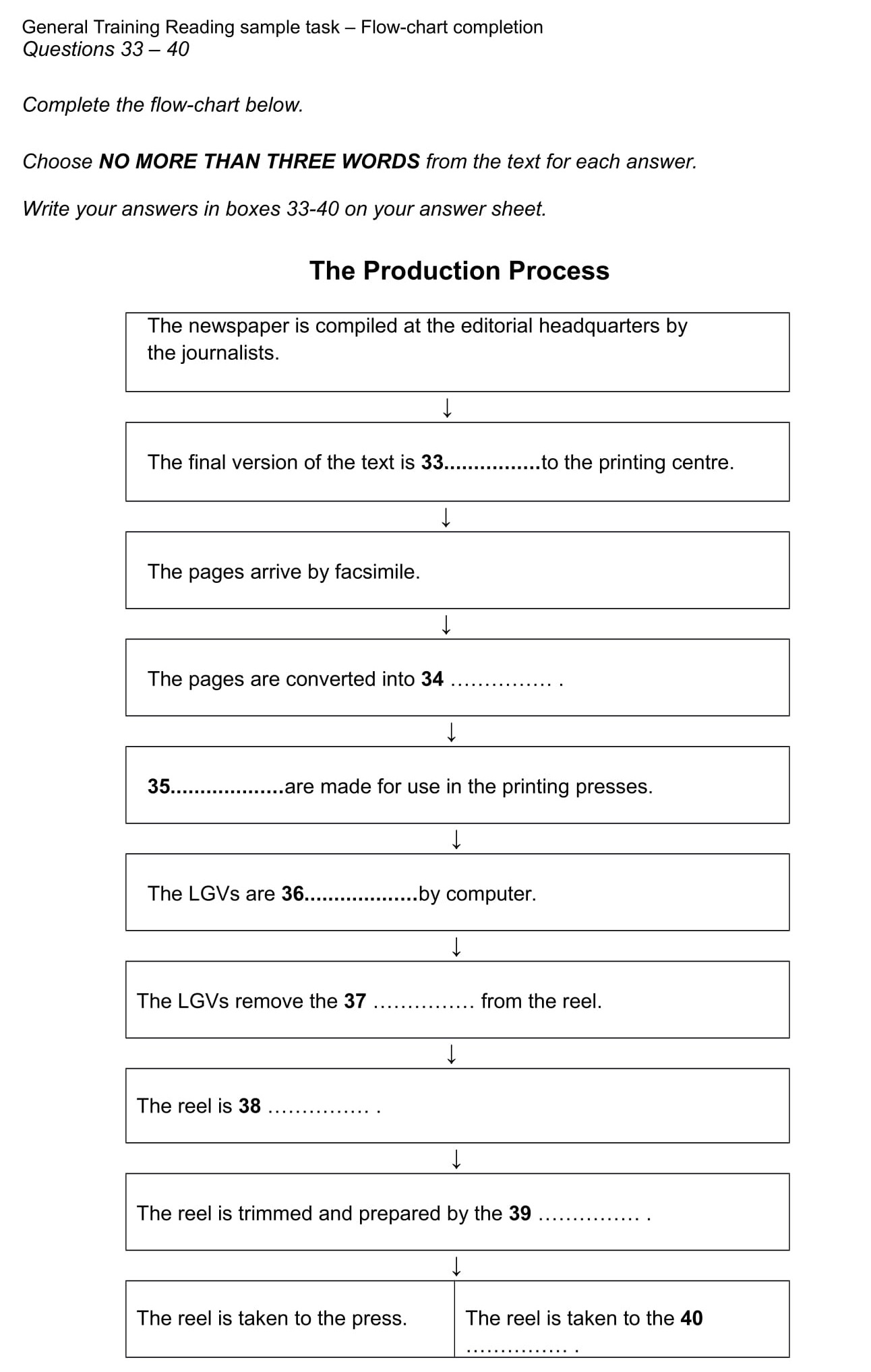
Source of IELTS Reading practice test: Official IELTS Website.
Step-By-Step Instructions
1) Start by carefully
reading the instructions to be sure that you know what you have to do.
2) Briefly look at the flowchart and try to get a general understanding of what it’s showing. The title tells us that it’s a flowchart of a production process.
We know from having worked on the text for the previous set of questions, that the text is about how robots are used to produce a newspaper. You will also have a reasonable knowledge of much of the content of the article which will be a great help.
3) Now look at the first sentence with a gap in it:
The final version of the text is 33.................. to the printing centre.
Scan the first two paragraphs of the text for the key words ‘printing centre’. They occur three times.
Next, read around them to find a reference to the ‘final version’ of the newspaper. Remember to be on the lookout for synonyms and paraphrasing.
What we’re looking for is in the first sentence of paragraph B.
Once the finished newspaper has been
created for the next morning’s edition, all the pages are transmitted
electronically from the prepress centre to the printing centre.
Now
that we know the location of the answer, we need to read the sentence in
details to identify the missing word.
The answer is: 33 transmitted.
‘Transmitted electronically’ would be fine as well as it’s within the word limit.
4) For the next answer, we could try scanning for the key word ‘converted’ but I’m guessing that a synonym will have been used.
The pages arrive by facsimile.
↓
The pages are converted into 34 …………… .
However,
there is a key word in the previous sentence in the flowchart (a sentence that doesn't have a missing word) that's more
likely to be present and will help us to find the location of the answer. It’s
‘facsimile’. Scan for this instead. Start scanning from the location of the
last answer.
'Facsimile' is present in the very next sentence so we should find the answer somewhere in the rest of this paragraph.
B ....The system of
transmission is an update on the sophisticated page facsimile system already in
use on many other newspapers. An imagesetter at the printing centre delivers
the pages as film. Each page
takes less than a minute to produce, although for colour pages four versions,
once each for black, cyan, magenta and yellow are sent. The pages are then
processed into photographic negatives
and the film is used to
produce aluminium printing plates ready for the presses.
Quickly
scan this section of the text to see if ‘converted’ is also present or an
obvious synonym of it. It isn’t. So, we need to skim read in order to find the information
that tells us that the pages are ‘converted’ or ‘changed’ into something else.
The information is contained in two different sentences (I’ve underlined them) and there are two possible answers – ‘film’ and ‘photographic negatives’. Since they are both essentially the same thing, either is acceptable.
Answer: 34 film or negative photographic
5) The key words in the next gap sentence are ‘printing presses’.
35 …………… are made for use in the printing presses.
Scan for these next. You may already have spotted them in the same sentence as the last answer, although they are separated by other text.
…the film is used to
produce aluminium printing
plates ready for the presses.
The
word ‘produce’ has been used as a synonym for ‘made’ but the information is the
same. Read the sentence in detail to identify the answer.
Answer: 35 aluminium plates
6) Sometimes it’s possible to make an educated
guess at the missing word from the context of the sentence and the next answer
is a good example of this.
The LGVs are 36 …………… by computer.
We already know from the Matching Headings questions that LGV’s are robots, so we need to think of a few words that will fit the sentence before scanning the text to identify the correct one.
Possible contenders are:
- operated
- controlled
- programmed
Now scan the text for ‘LGV’s and ‘computer’ to see if one of these words appears in the same sentence as them.
Paragraph D has what we’re looking for.
Once the size of the
day’s paper and the publishing order are determined at head office, the
information is punched into the computer
and the LGVs are programmed to go about their
work.
Answer: 36 programmed
7) The next gap sentence is about the reels of paper. A glance at the remaining sentences in the flowchart reveals that all the rest
are also on this subject.
The LGVs
collect the reels of paper.
The LGVs remove the 37 …………… from the reel.
The reel is 38 …………… .
The reel is trimmed and prepared by the 39 …………… .
The reel is taken to the press.
The reel is taken to the 40
…………… .
The next key words to scan for is obviously reel/reels.
Scanning
from the location of the last answer, we find reel/reels 12 times in paragraphs D and E. All the answers should be in this
section of text.
We now need to scan again for key words from each gap sentence.
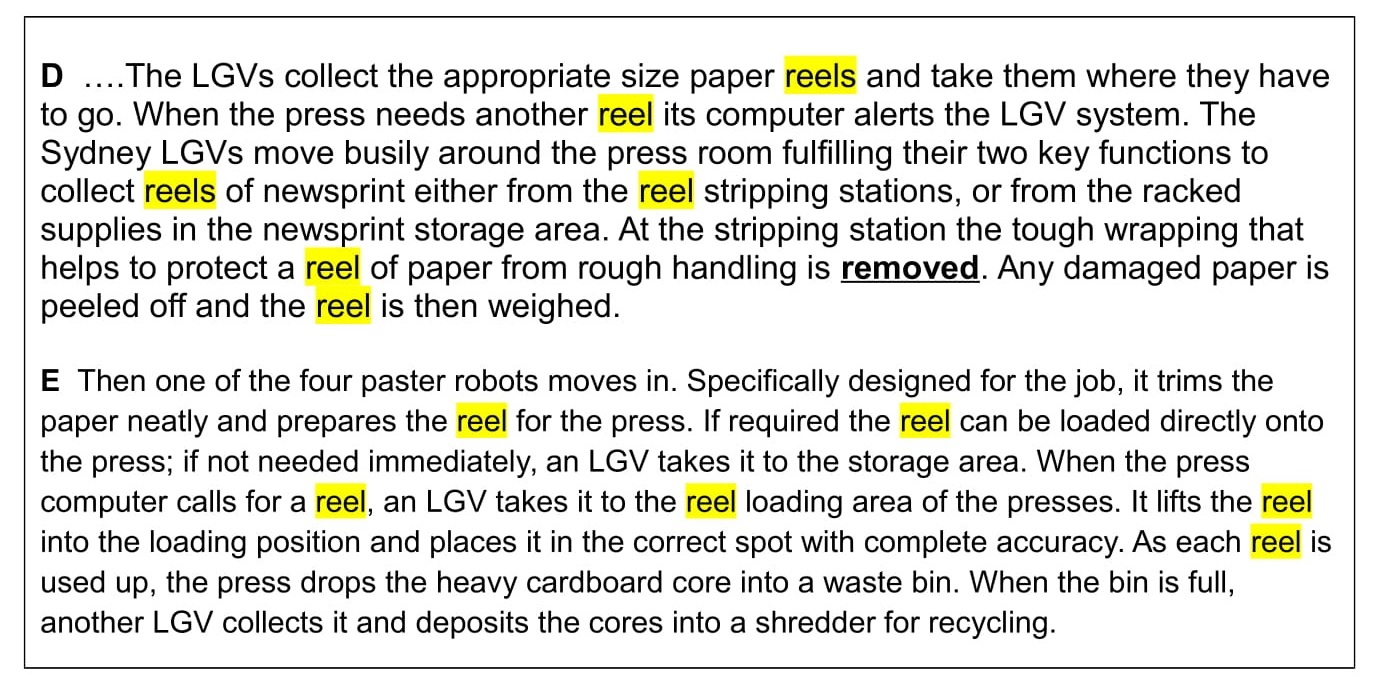
8) The next word to scan for is ‘remove’ or a synonym of it.
The LGVs remove the 37 …………… from the reel.
It is present towards the end of paragraph D. Now read in detail for the answer.
At
the stripping station the tough wrapping that helps to protect a reel of
paper from rough handling is removed.
Any damaged paper is peeled off and the reel is then weighed.
There are two possible answers and both are acceptable.
Answer: 37 wrapping or damaged paper
9) There’s little information in the next sentence to help us identify the answer (The reel is 38 …………… .) so, we’ll move on to 39 and come back to it.
The reel is trimmed and prepared by the 39 …………… .
Scan for ‘trimmed’ or ‘cut’, which means the same thing.
Then one of the four
paster robots moves in. Specifically designed for the job, it trims the paper neatly and
prepares the reel for the press.
Read
in detail for the answer.
Answer: 39 paster robots
10) Now we should be able to work out answer 38 as it will be located between answers 37 and 39.
The reel is 38 …………… .
Any (38) damaged paper is peeled off and
the reel is then weighed.
E Then one of the four (39) paster robots moves in.
Answer: 38 weighed
11) Finally in our IELTS reading practice test, we come to the last answer.
The reel is taken to the 40 …………… .
Since we are nearly at the end of the text, and there is no outstanding key word in this sentence, the quickest way to find the answer is to read on in detail until we locate it. It should come very soon after the previous answer. In fact, it’s in the next sentence.
If required the reel can be loaded directly onto the press; if not needed immediately, an LGV takes it to the storage area.
Answer: 40 storage area
We’ve now completed both parts of this IELTS reading practice test.
I hope you've found these instructions on how to answer the two sets of questions helpful. Use what you’ve learnt to answer other similar questions.
As already mentioned, I've created a full page on each of the question types covered on this page.
Don’t forget that there are lots more tips for answering these types of question, including more IELTS reading practice tests, on these pages: Matching Heading & Diagram Labelling
Answers
Matching Headings
27 Paragraph
A v
28 Paragraph B vii
Example: Paragraph C ix
29 Paragraph D iv
30 Paragraph E i
31 Paragraph F viii
32 Paragraph G iii
Answers
Diagram Labelling
33 transmitted (electronically
34 (photographic) film/negative(s)
35 (aluminium) printing plates
36 programmed
37 damaged paper/wrapping
38 weighed
39 paster robot(s)
40 storage area
Words
in brackets are optional - they are correct, but not necessary. Alternative
answers are separated by a slash
(/).
Like this page?
Find More IELTS Reading Practice Tests
on These Pages
Step-by-step strategies for answering the 12 different types of IELTS Reading questions with examples and practice tests.
You'll Also Find IELTS Reading Practice Tests Here:
IELTS Reading Sample – True, False, Not Given sample test
IELTS Reading Samples – Matching Headings & Diagram Labelling sample tests
IELTS Reading Exercise – Yes, No, Not Given sample test
More Reading Test Practice – Matching Information sample test
IELTS Reading Tests – Two strategies for answering Name Matching questions
IELTS Reading Paper – Multiple Choice sample test
Reading Tests For IELTS – Summary Completion test
